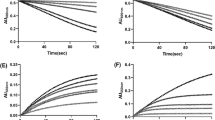Abstract
Spectrophotometric and fluorimetric substrate couple titrations and potentiometric spectrophotometric titrations were used to determine the oxidation-reduction potentials of components showing absorbance or fluorescence at the wavelengths attributable to the flavoproteins of mitochondria fractionated using digitonin together with sonication. A pure mitoplast fraction devoid of cytochrome b5 contamination could be obtained using 230 µg digitonin/mg of mitochondrial protein. The digitonin-soluble fraction contained a species havingE m 7 .4=−123 mV and probably represents the outer membrane flavoproteins. The inner membrane-matrix fraction, treated with ultrasound, provided evidence of a flavoprotein species with low redox potential (E m 7 .4=−302 mV) in the matrix fraction. The −302 mV component is probably lipoamide dehydrogenase. A high redox potential species withE m 7 .4=+19 mV in titrations with the succinate fumarate couple was located in the inner membrane vesicles and is probably identical with succinate dehydrogenase. The electron-transferring flavoprotein (ETF) was isolated from bovine heart mitochondria and itsE m 7 .4=−74 mV determined. The component in the matrix fraction with an apparentE m 7 .4=−56 mV probably represents ETF, and that in the inner membrane fraction with an apparentE m 7 .4=−43 mV the NADH dehydrogenase flavoprotein. A component in an apparently low concentration withE m 7 .4=+30 mV was detected in the inner membrane fraction. This probably represents the ETF-dehydrogenase flavoprotein. The origin of the flavoprotein fluorescence of mitochondria and intact tissues is discussed.
Similar content being viewed by others
References
I. E. Hassinen and K. Hiltunen,Biochim. Biophys. Acta,408 (1975) 319.
B. Chance, L. Ernster, P. B. Garland, C.-P. Lee, P. A. Light, T. Ohnishi, C. I. Ragan, and D. Wong,Proc. Nat. Acad. Sci. U.S.A.,57 (1967) 1498.
I. Hassinen and B. Chance,Biochem. Biophys. Res. Commun.,31 (1968) 895.
C. I. Ragan and P. B. Garland,Eur. J. Biochem.,10 (1969) 399.
M. Erecinska, D. F. Wilson, Y. Mukai, and B. Chance,Biochem. Biophys. Res. Commun.,41 (1970) 386.
T. Ohnishi,Biochim. Biophys. Acta,301 (1973) 105.
P. L. Dutton and D. F. Wilson,Biochim. Biophys. Acta,346 (1974) 165.
O. H. Lowry, G. J. Rosebrough, A. L. Farr, and R. J. Randall,J. Biol. Chem.,193 (1951) 265.
K. F. Tipton,Biochim. Biophys. Acta,135 (1967) 910.
W. C. Schneider,J. Biol. Chem.,176 (1948) 259.
T. L. Chan, J. W. Greenawalt, and P. L. Pedersen,J. Cell Biol.,45 (1970) 291.
H. Löw and I. Vallin,Biochim. Biophys. Acta.,69 (1963) 361.
C. L. Hall, L. Heijkensköld, T. Bartfai, L. Ernster, and H. Kamin,Arch. Biochem. Biophys.,177 (1976) 402.
C. L. Hall and H. Kamin,J. Biol. Chem.,250 (1975) 3476.
H. A. Krebs, J. Mellanby, and D. H. Williamson,Biochem. J.,82 (1962) 96.
D. H. Williamson, P. Lund, and H. A. Krebs,Biochem. J.,103 (1967) 514.
H. Borsook and H. F. Schott,J. Biol. Chem.,92 (1931) 535.
D. W. Allman, L. Galzigna, R. E. McCaman, and D. E. Green,Arch. Biochem. Biophys.,117 (1966) 413.
E. Bachmann, D. W. Allman, and D. E. Green,Arch. Biochem. Biophys. 115 (1966) 153.
D. E. Green, E. Bachmann, D. W. Allmann, and J. F. Perdue,Arch. Biochem. Biophys.,115 (1966) 172.
D. F. Parsons, G. R. Williams, and B. Chance,Ann. N.Y. Acad. Sci.,137 (1966) 643.
G. L. Sottocasa, B. Kuylenstierna, L. Ernster, and A. Bergstrand, inMethods in Enzymology, R. W. Estabrook and M. E. Pullman (eds.), Academic Press, New York, 1967, Vol. 10, p. 448.
C. Schnaitman, V. G. Erwin, and J. W. Greenawalt,J. Cell Biol.,32 (1967) 719.
C. Schnaitman and J. W. Greenawalt,J. Cell Biol.,38 (1968) 159.
C. Hoppel and C. Cooper,Biochem. J.,107 (1968) 367.
M. Lévy, R. Toury, and J. Andre,Biochim. Biophys. Acta.,135 (1969) 599.
J. W. Greenawalt and C. Schnaitman,J. Cell Biol.,46 (1970) 173.
W. J. Frisell, M. V. Patwardhan, and S. G. Mackenzie,J. Biol. Chem.,240 (1965) 1829.
L. Ernster, L. Danielson, and M. Ljunggren,Biochim. Biophys. Acta.,58 (1962) 171.
P. B. Garland, B. Chance, L. Ernster, C.-P. Lee, and D. Wong,Proc. Natl. Acad. Sci. U.S.A.,58 (1967) 1696.
G. Palmer and V. Massey, inBiological Oxidations, T. E. Singer (ed.), 1968, Interscience, New York, pp. 263–300.
J. G. Hauge,J. Am. Chem. Soc.,78 (1956) 5266.
F. J. Ruzicka and H. Beinert,Biochem. Biophys. Res. Commun.,66 (1975) 622.
E. B. Kearney,J. Biol. Chem.,235 (1960) 865.
T. Ohnishi, D. B. Winter, J. Lim, and T. E. King,Biochem. Biophys. Res. Commun.,53 (1973) 231.
T. Bücher and M. Klingenberg,Angew. Chemie.,70 (1958) 552.
Author information
Authors and Affiliations
Rights and permissions
About this article
Cite this article
Voltti, H., Hassinen, I.E. Oxidation-reduction midpoint potentials of mitochondrial flavoproteins and their intramitochondrial localization. J Bioenerg Biomembr 10, 45–58 (1978). https://doi.org/10.1007/BF00743226
Received:
Issue Date:
DOI: https://doi.org/10.1007/BF00743226




